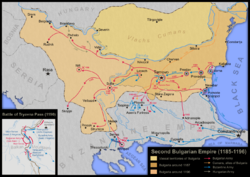Uprising of Asen and Peter facts for kids
Quick facts for kids Uprising of Asen and Peter |
|||||||||
|---|---|---|---|---|---|---|---|---|---|
 Bulgaria during the uprising |
|||||||||
|
|||||||||
| Belligerents | |||||||||
| Bulgarians Vlachs Supported by: Cumans |
Byzantine Empire | ||||||||
| Commanders and leaders | |||||||||
| Ivan Asen I Peter IV |
Isaac II Angelos John Doukas John Kantakouzenos Alexios Branas |
||||||||
The Uprising of Asen and Peter was a big rebellion by the people of Bulgaria and Vlach areas. These lands were then part of the Byzantine Empire. The uprising started because the Byzantine emperor raised taxes a lot. It began in 1185 and led to the creation of a new Bulgarian state, called the Second Bulgarian Empire. This new empire was led by the Asen dynasty.
Contents
Why Did the Uprising Start?
High Taxes and Unfair Treatment
The Byzantine Emperor, Isaac II Angelos, needed money for his wedding. So, he decided to collect new, very high taxes. These taxes hit the people living in the Haemus Mountains (now the Balkan Mountains) especially hard.
The people sent two leaders, Peter and Asen, to talk to the emperor. They traveled to a place called Kypsella. They asked if their people could join the Byzantine army. They also wanted land near the mountains to help them pay the new taxes.
But the emperor said no to their requests. He also treated Peter and Asen very badly. This made the brothers furious, and they threatened to start a rebellion.
How Did the Rebellion Begin?
Inspiring the People
When Peter and Asen returned home, many people were scared to join a rebellion. To convince them, the brothers built a church in Tarnovo. It was dedicated to Saint Demetrius, a very important saint.
Saint Demetrius was usually seen as a protector of the Byzantine city of Thessaloniki. But Peter and Asen told everyone that the saint had now decided to help the Bulgarians and Vlachs instead. They said, "God wants to free the Bulgarians and Vlach people!" This message gave people hope and courage.
After this, their followers started attacking Byzantine cities. They took prisoners and animals. They even raided Preslav, which used to be the capital of the First Bulgarian Empire. This was a big symbolic moment. After this, Peter took the title of Tsar, which means emperor.
Byzantine Counter-Attacks
Emperor Isaac's First Move
In the spring of 1186, Emperor Isaac II launched his own attack against the rebels. At first, he was successful. During a solar eclipse on April 21, 1186, the Byzantines attacked the rebels by surprise. Many rebels had to flee north, across the Danube River. There, they met other Vlach people and the Cumans, who were a nomadic group.
In a symbolic act, Isaac II went into Peter's house and took an icon (a religious image) of Saint Demetrius. He hoped this would show that the saint was now on his side again. Isaac then quickly returned to Constantinople to celebrate his victory.
Rebels Regain Strength
However, Isaac's quick return was a mistake. The Bulgarian and Vlach armies came back, stronger than before. They had been joined by the northern Vlachs and their Cuman allies. They found the region undefended. They not only took back their old lands but also captured all of Moesia. This was a huge step towards creating their new Bulgarian state.
New Byzantine Generals
The emperor then put his uncle, John, in charge of the war. John won some battles, but then he rebelled against the emperor himself!
So, Isaac replaced him with his brother-in-law, John Kantakouzenos. John was a good planner, but he didn't understand the "guerrilla warfare" tactics the mountain rebels used. His army was ambushed and lost many soldiers after chasing the enemy into the mountains.
The third general sent to fight the rebels was Alexius Branas. He also rebelled and marched his army towards Constantinople! Isaac managed to defeat him with help from another relative. But all this fighting among the Byzantines meant less attention was paid to the rebels. Isaac could only send a new army in September 1187.
The End of the Uprising
Siege of Lovech and Truce
The Byzantines won a few small victories before winter. But the rebels, with help from the Cumans and their clever mountain tactics, still had the upper hand.
In the spring of 1187, Isaac attacked the fortress of Lovech. He tried for three months but couldn't capture it. At this point, the lands between the Haemus Mountains and the Danube were completely lost to the Byzantine Empire.
This led to a truce (a peace agreement). The truce officially recognized that Asen and Peter now ruled this territory. This was the moment the Second Bulgarian Empire was truly created. The only good news for the emperor was that he held Asen's wife and a young man named John (who would later become Kaloyan of Bulgaria, a future leader) as hostages.

